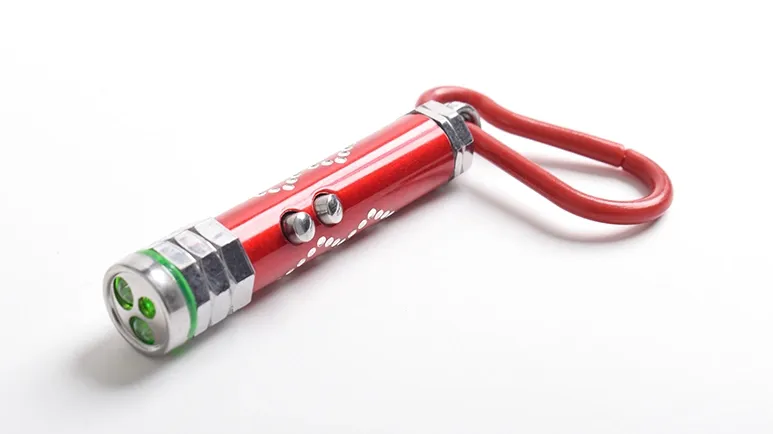Is Your Pet's Favorite Toy Secretly a Hidden Stressor?
Is this popular toy really the harmless entertainment it appears to be, or is it secretly stressing your pet? Read this article to find out.

STORY AT-A-GLANCE
- Laser toys ignite cats' natural hunting instincts, but endless chasing without a catch can leave them frustrated, anxious, and even aggressive toward people or other pets
- What seems like playful excitement can mask stress, as the constant pursuit of an uncatchable light keeps cats' "fight or flight" system switched on
- Eye injuries and collisions are real risks when cats chase laser dots without spatial awareness. Even low-powered beams can damage sensitive eyes
- Healthy play needs closure. Ending laser sessions with a toy or treat helps complete the hunting cycle and prevents emotional stress or obsession
- Safer alternatives like feather wands and interactive toys let cats hunt, pounce, and "win," giving them both physical exercise and emotional satisfaction without frustration
You've probably seen it a hundred times — your cat crouches low, pupils wide, tail twitching with anticipation. You flick your wrist, and a tiny red dot darts across the floor. In an instant, your feline friend is off, racing after it with the intensity of a lion on the savanna. The scene is adorable, funny, and, let's face it, wildly entertaining.
Laser pointers have become a go-to toy for cat owners everywhere. They're inexpensive, easy to use, and seem to offer endless fun. But beneath that lively play session, something deeper might be happening. For some cats, that little red light isn't just play — it's stress, frustration, and even a potential source of harm.
The Allure of the Laser Light
Cats are natural hunters. Even if your cat spends most of the day sleeping in the sun or relaxing on the couch, their instinct to chase and hunt remains strong. Every wiggle, pounce, and tail flick ties back to their wild instincts — the deep-rooted drive to hunt prey.
That’s exactly why laser pointers are so mesmerizing. The light moves unpredictably — darting, stopping, and changing direction just like a mouse or insect might. The bright color and sudden motion trigger your cat’s prey drive, sparking a rush of excitement and engagement.1,2
For indoor cats, especially, laser play can be a thrilling way to release pent-up energy. It gets their heart pumping, their reflexes firing, and their minds alert. Even short sessions can provide excellent exercise and mental stimulation, both crucial for cats that spend most of their time indoors.
When Fun Turns Frustrating
But what makes this toy so irresistible is also what makes it risky. Imagine playing a game of tag where you can never win. No matter how fast you run or how clever your moves, the goal is always just out of reach. That's what a laser pointer can feel like for your cat.
Unlike toys that can be grabbed, bitten, or batted around, a laser beam has no physical substance. Your cat can chase the red dot for hours, but they can never actually "catch" it. This creates what experts call an incomplete hunting cycle — the natural sequence of stalking, chasing, catching, and "killing" prey.3,4
In nature, completing this cycle provides a sense of satisfaction and emotional closure. When the hunt is successful, a cat's brain releases feel-good chemicals that reduce stress. But when the "prey" always slips away, the hunt becomes endlessly frustrating. Over time, this frustration can lead to several behavioral and emotional issues:
- Anxiety or agitation — Your cat might seem restless or overly alert, pacing or meowing after playtime.
- Obsessive behaviors — Some cats start fixating on light reflections, shadows, or even dust motes, unable to turn off their hunting mode.
- Redirected aggression — When the hunt feels incomplete, your cat might lash out by swatting at other pets or even you, the nearest "movable target."
These reactions are your cat's way of trying to finish the hunt that never truly began.
When Play Becomes Stressful
Beyond frustration, laser play can actually raise your cat's stress hormones. The constant pursuit without payoff keeps their sympathetic nervous system, which is the "fight or flight" system, in overdrive. That may look like excitement on the outside, but inside, it's adrenaline overload.
Cats who frequently engage in this kind of unresolvable chase can develop symptoms similar to stress or overstimulation. In extreme cases, intense laser play can cause seizures in young kittens.5 While rare, it's a reminder that what seems like harmless fun can push your cat's body beyond a healthy limit.
The Physical Risks You Might Not Expect
Laser play also comes with physical risks. Because cats become so focused on the "prey," they may lose awareness of their surroundings. It's not unusual for a cat to run into furniture, slip on hardwood floors, or even crash into walls during a high-speed chase.6
And then there's the issue of eye safety. Even low-powered lasers can cause severe eye damage if shone directly into your cat's eyes, or anyone's, for that matter. A brief flash might not cause visible injury, but repeated or direct exposure can lead to retinal damage or vision problems over time.7,8
Most pet-safe laser pointers are designed to minimize these risks, but accidents can happen, especially with curious cats who tend to look up or leap toward the beam's source.
Signs Laser Play May Stress Your Cat
Because cats often hide their stress well, it's essential to watch for subtle cues that your laser sessions might be doing more harm than good. Signs can include:
- Restlessness after playtime
- Overgrooming or excessive licking
- Fixation on lights, reflections, or moving shadows
- Unprovoked aggression toward people or pets
- Loss of interest in other toys
- Avoidance behaviors or sudden withdrawal
If you notice any of these patterns, your cat may be experiencing laser frustration, the mental strain of chasing something they can never catch.
Alternatives That Bring Out the Joy Without the Stress
Cats crave the hunt, but they also crave success. The best toys allow them to stalk, pounce, catch, and "kill," satisfying every step of the hunting process. Here are a few tried-and-true alternatives that provide the same thrill without the potential downsides.
- Feather wands and teasers — These are classic for a reason. Wand toys with feathers, strings, or fuzzy attachments mimic the erratic motion of birds or insects. They give your cat a real object to chase and bite, completing the hunting experience.
- The "Cat Dancer" — Recommended by shelters like SpayMart, this simple wire-and-cardboard toy moves unpredictably, making it irresistible to cats. It's affordable, safe, and encourages your cat to use natural hunting postures — crouching, leaping, and swatting.
- Interactive mice and moving toys — Battery-powered or remote-controlled toys simulate live prey and keep cats engaged for long periods. These toys move erratically and can be caught, clawed, and "defeated."
- Puzzle feeders and treat balls — These combine play with mealtime, engaging your cat's mind while rewarding them with food. They're perfect for cats who need both mental stimulation and portion control.
- Bubble toys and rolling balls — Yes, there are even cat-safe bubble makers that release edible bubbles flavored like catnip or tuna. These provide gentle motion, allowing your cat to pounce and pop without frustration.
Laser Play for Dogs — A Hidden Hazard, Too
While this article focuses mainly on cats, it's worth noting that dogs aren't immune to laser stress either. Many dogs, especially high-energy breeds, also enjoy chasing laser dots, but the effects can be more concerning.
Dogs are less visually driven and more reliant on smell. When a laser dot moves without a scent to track, it confuses their brains. Over time, some dogs develop obsessive-compulsive behaviors, like chasing reflections, staring at light spots, or even snapping at invisible dots on the floor or walls.
Veterinarians have documented cases of dogs developing light-chasing OCD, a behavioral disorder that can be extremely difficult to reverse. What starts as innocent fun can quickly spiral into a lifelong compulsion.
If your dog loves the chase, try replacing the laser pointer with physical fetch toys or treat-based games instead. A bouncing ball, a squeaky toy, or a tug rope provides the same excitement — but with a real, tangible payoff.
Bringing Balance Back to Playtime
The goal of any pet play session isn't just exercise, it's emotional fulfillment. Toys should bring joy, not confusion. For cats, that means honoring their instincts in ways that provide closure and satisfaction. Here are a few ways to restore balance to your cat's play routine:
- Rotate toys regularly — This keeps things fresh and prevents boredom.
- Mix chase games with tactile ones — Follow laser play with toys that your cat can physically catch.
- Offer daily structured playtime — Two 10- to 15-minute sessions per day are usually enough for most cats.
- Incorporate rest and reward — End every session calmly, with a treat, gentle petting, or quiet bonding time.
- Provide enrichment outside of play — Window perches, bird feeders, and scratching posts help satisfy curiosity and hunting instincts even when you're not around.
By respecting your cat's emotional and physical limits, you'll transform playtime from frantic chasing to genuine connection.
When to Seek Professional Help
If your cat becomes obsessed with chasing lights, reflections, or shadows even outside of playtime, it's best to consult your veterinarian or a feline behavior specialist. What starts as light play can sometimes evolve into compulsive behavior disorder (CBD), a condition that may require professional guidance or behavioral therapy.
Your vet can help determine whether the behavior is stress-related, neurological, or environmental. They can guide you toward safe enrichment options that suit your cat's unique personality and health.
The Bigger Picture — What Play Means for Pets
Play isn't just about fun; it's a vital part of your pet's well-being. For cats, it mimics the hunt; for dogs, it channels energy and strengthens bonds. But the type of play matters.
A toy that excites your pet but never rewards them can actually cause chronic stress. Just as humans feel anxious when they can't meet a goal, pets feel uneasy when their instincts are left hanging. That's why it's so important to choose toys that fulfill both physical and emotional needs.










